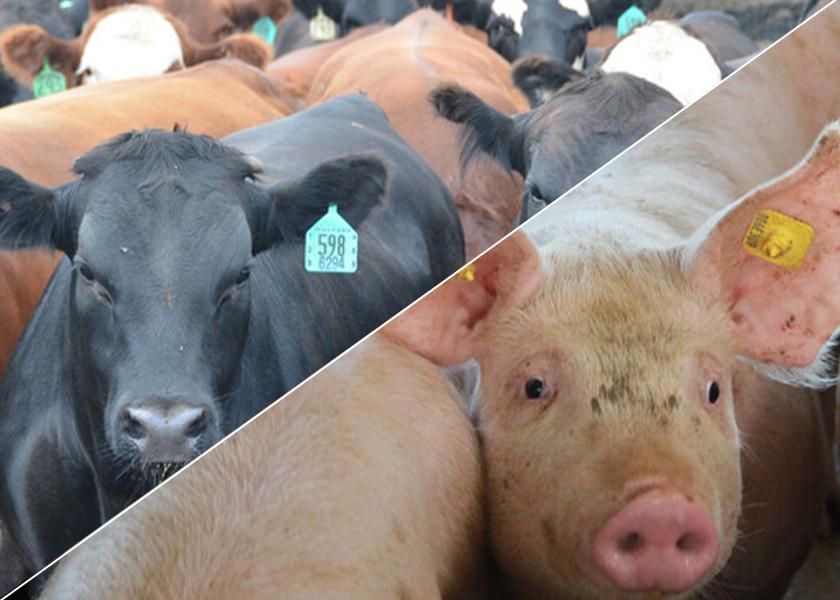Livestock Analysis | Oct. 14, 2022

Hogs
Price action: Oct hogs went off the board at noon today, settling at $93.375. December hogs hit a more-than-two-week high and rose $1.65 to $82.25. For the week, December hogs gained $5.10.
5-day outlook: Today’s futures price surge that included a technically bullish weekly high close in December futures sets the table for follow-through, chart-based buying early next week. The October lean hog contract expired well above Wednesday’s official CME lean hog index figure at $92.67, and still above Thursday’s preliminary index quote at $93.09, up 42 cents from the day before. That suggests more strength in the cash hog market next week. The national direct five-day rolling average cash price quote today is $86.24. Pork cutout value at noon today rose 26 cents at $103.33, led by gains in picnics. Movement at midday was good at 224.06 loads.
30-day outlook: While general weakness in the cash hog market is expected through the end of the year, the recent futures price strength suggests an early seasonal low may be in place. However, U.S. pork export sales need to improve to better suggest such. USDA today reported U.S. pork export sales were 29,200 MT for week ended Oct. 6. Exports for the week were 28,500 MT. We still believe a shortage of turkeys and diminished stockpiles of hams for the holiday season will provide support for the hog market. Ham stocks ended August at 163.527 million lbs., down 18% from the average for the past 10 years. USDA’s Oct. 24 Cold Storage Report will offer fresh insight.
90-day outlook: Hog supplies are expected to be slightly lower than year-ago levels in the coming months. It’s likely consumer demand for pork demand will hold up well, especially with higher-priced beef cuts. Red meat consumption during economic slowdowns or recessions does not decline significantly, as consumers opt to eat out less, but in doing so tend to eat more red meat at home. This suggests hog and pork prices will remain supported in the coming months. A potential negative for the pork industry in the coming months is the strong value of the U.S. dollar, making U.S. pork more expensive on the world markets.
What to do: Get current with advised soymeal coverage. Be prepared to extend coverage on additional price pressure.
Hedgers: Carry all risk in the cash market for now.
Feed needs: You have 100% of soybean meal needs through mid-November covered in the cash market. You are hand-to-mouth on corn-for-feed needs.
Cattle
Price action: Nearby October live cattle futures ended the week at $146.95, having posted a 50-cent daily gain and closing at its highest level since reaching a contract high of $147.50 on April 22. Most-active December slipped 15 cents along with the deferred contracts, settling at $147.775; that marked a weekly decline of 27.5 cents. November feeder futures fell $1.325 to $174.775, which represented a weekly loss of 85 cents.
5-day outlook: Look for sustained cash strength again next week, especially after producers proved able to force cash prices higher this week. The five-area average for Monday-Thursday reached $146.77, up 80 cents from last week. That essentially represented across-the-board gains in the various states/regions covered by the report. Having wholesale quotes edge upward again this morning, with Choice cutout rising another 72 cents to $247.25, also looks favorable to sustained strength. Bears still seem focused on recessionary economic prospects and ideas red meat demand will suffer in such conditions, as indicated by the sustained weakness exhibited by the deferred contracts.
30-day outlook: Late-week gains by Select-grade beef narrowed the Choice-Select spread from over $33.00 at Tuesday’s close to $29.71 at midsession Friday, but the strength of that spread versus the historical mid-October norm around $14.00 serves as the best indication of the tightness of market-ready fed cattle and high-grade beef supplies. We don’t see that improving, especially if/when wet, cold weather hits feedlots strewn across the Great Plains. We believe the benign weather that has dominated Plains weather this fall has led to phenomenal performance by feedlot cattle, thereby enabling the industry to slaughter cattle at 4% over year-ago levels since late August. The increased packer activity was likely driven by strong demand rather than excess supply, which again favors price strength. We don’t see this changing over the next 30 days, or during the winter.
90-day outlook: Long-range weather forecasts suggest little chance of a cold, snowy winter over the Plains states, so a big weather-driven rally in which feedlot cattle are suffering inordinately from wintry conditions seems unlikely. Still, the arrival of winter will almost surely have the normal effect of reducing the weight/feeding performance of feedlot cattle, thereby cutting market-ready supplies. Conversely, we don’t see consumer demand suffering all that badly in recessionary conditions, since we believe consumers curb their visits to restaurants at such times, but increase their purchases at grocery stores, which ultimately leads to steady or even stronger overall demand for beef and pork. Thus, we expect at least a ‘normal’ cattle market advance through late fall, winter and early spring.
What to do: Get current with advised soymeal coverage. Be prepared to extend coverage on additional price pressure.
Hedgers: Carry all risk in the cash market for now.
Feed needs: You have 100% of soybean meal needs through mid-November covered in the cash market. You are hand-to-mouth on corn-for-feed needs.






